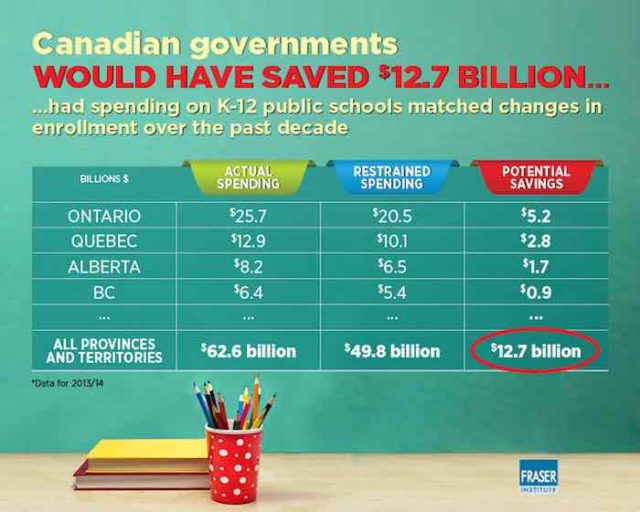Fiscal Consequences of Higher Spending on K-12 Public Schools
 The economic woes of the public school system in Canada seem to handle their school funding just as badly as we do in the States. ~ J.B.
The economic woes of the public school system in Canada seem to handle their school funding just as badly as we do in the States. ~ J.B.
Governments across Canada could have collectively saved $12.7 billion in 2013/14 – and lessened their debt and deficit burdens – if they had restrained spending increases on public schools to changes in enrollment and overall prices (inflation) during the previous decade, finds a new study by the Fraser Institute, an independent, non-partisan Canadian public policy think-tank.
Instead, while public school enrollment (elementary and secondary) declined across Canada by more than four per cent between 2004/05 and 2013/14, per-student public school spending increased by 25.8 per cent, even after accounting for inflation.
“Spending decisions in one area have broader effects on a government’s bottom line. Looking at public school spending as an example, if spending increases had been restrained to account only for enrollment changes and inflation, the fiscal situation in many provinces right now would be markedly better,” said Charles Lammam, director of fiscal studies at the Fraser Institute.
The study, Fiscal Consequences of Higher Spending on K-12 Public Schools in Canada, finds that the significant increase in per-student spending—over and above enrollment changes and inflation—contributed to deeper budget deficits in all but two provinces in 2013/14.
For instance, had the Ontario government linked public school spending starting in 2004/05 with inflation and enrollment, Queen’s Park would have saved $5.2 billion in 2013/14, cutting the province’s $10.5 billion deficit in half.
Likewise, with restrained public school spending, Quebec would have essentially returned to a balanced budget in 2013/14 instead of 2015/16, and Prince Edward Island would have also recorded a small surplus instead of a $46 million deficit.
In Alberta, had increases in public school spending been restrained, Alberta’s $302 million deficit in 2013/14 would have been a $1.4 billion surplus.
“Failure to restrain increases in public school spending has consequences, as provincial governments run deeper deficits and increase the debt burden on future generations,” said Ben Eisen, Fraser Institute’s director of provincial prosperity studies.
 Written for the Fraser Institute and published by Canada Free Press ~ February 9, 2017.
Written for the Fraser Institute and published by Canada Free Press ~ February 9, 2017.
 FAIR USE NOTICE: This site contains copyrighted material the use of which has not always been specifically authorized by the copyright owner. We are making such material available in our efforts to advance understanding of environmental, political, human rights, economic, democracy, scientific, and social justice issues, etc. We believe this constitutes a ‘fair use’ of any such copyrighted material as provided for in section 107 of the US Copyright Law. In accordance with Title 17 U. S. C. Section 107, the material on this site is distributed without profit to those who have expressed a prior interest in receiving the included information for research and educational purposes. For more information go to: http://www.law.cornell.edu/uscode/17/107.shtml
FAIR USE NOTICE: This site contains copyrighted material the use of which has not always been specifically authorized by the copyright owner. We are making such material available in our efforts to advance understanding of environmental, political, human rights, economic, democracy, scientific, and social justice issues, etc. We believe this constitutes a ‘fair use’ of any such copyrighted material as provided for in section 107 of the US Copyright Law. In accordance with Title 17 U. S. C. Section 107, the material on this site is distributed without profit to those who have expressed a prior interest in receiving the included information for research and educational purposes. For more information go to: http://www.law.cornell.edu/uscode/17/107.shtml
